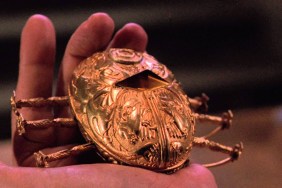
New column SHOCKing Smackdown pits related horror movies against one another for cinematic supremacy.
Director Stephen Norrington and writer David S. Goyer’s 1998 Marvel Comics adaptation BLADE blindsided me, as it did many viewers. The film featured action star Wesley Snipes as the titular half-vamp hero, a contemporary incarnation of the tough-talking character first introduced in Marvel’s TOMB OF DRACULA title in the early ’70s, here re-invented as a sullen, haunted amalgam of Batman, Mifune-esque samurai and Clint Eastwood’s “The Man With No Name”. Mixing pummeling electronic music, berserkly choreographed martial arts battles, expert swordplay and an arch, pulp narrative to batter its audience, the film was a box office hit, opening the floodgates for more Marvel movies and immediately forging a cult that bridged the thrill-starved mainstream with the more mutant-minded horror crowd.
18 years later, BLADE still stands up, for many reasons.
The first is, of course, Snipes himself. Decked out in leather and wraparound shades, Snipes’ self-loathing blood addict, wielding his weapons and carving through the sneering undead with as much of a smile as his solemn mug can muster, is a real presence. And it’s how we first see him that Norrington fully announces just how serious he is about making a movie that matters. After Traci Lords drags a hapless mortal to a vampire-choked “blood rave”, sprinklers dripping gore soak the ghoulish ravers intent on ripping the poor dude apart while a pulverizing remix of New Order’s “Confusion” thumps on the speakers. Suddenly, the blood stops spraying and Blade stands in the middle of the room, confidently drawing his samurai circle with his sword and smirking, before more techno explodes and vampire challengers are cut down, bursting into cartoonish – and awesome – CGI skeleton flames.

Seeing this film on opening night, which I did, was astonishing. You could hear the audience gasp, collectively. Some applauded. Some screamed, some hollered. It was one of the most exciting cinematic experiences I’d ever had.
There are more kinetic bursts of action violence (that beat THE MATRIX’s kung-fu fantasy fights to the punch by almost a full year) peppered throughout BLADE, but that’s not what makes it so good. That’s sweet icing, certainly, those are the money-shots. But it’s BLADE’s valleys, man, not just it’s peaks, that stick with you.
Singer/songwriter/actor/outlaw Kris Kristofferson’s presence as Blade’s surrogate father and enabler Whistler, amateur scientist and weapon-forger, balances the mania of the action sequences and grounds the film in morality and, for lack of a better word, love. Whistler loves Blade, loves his boy. On the surface, he uses him as an avenging angel in his bid to eliminate the world’s vampires but underneath that, Whistler worries about his “son”. He knows that Blade will blaze into the heart of danger no matter what, so he tries to guide him, protect him, give him a home, give him safe harbor.
Kristofferson is excellent in the role and the dynamic between the two men is moving.
BLADE is grandiose and, despite the character’s own conflicted nature, there is a clear cut battle between good and evil at play here that stirs the blood.

Stephen Dorff is petulant, privileged evil personified in his portrayal of Blade’s nemesis Deacon Frost. Frost is a real horror, taking over the “youth” vampire subculture in a bid to overturn the entire vampire nation while challenging Blade and anyone else to dare bring him down. He cackles and sneers and his deeper relation to Blade makes the titanic revenge showdown at the climax one of the most fist-pumping in film history.
Oh yeah…and Udo Kier is in it. So…
What’s amusing is that any criticism I’ve seen larded upon BLADE rests in those wonderful “quiet” moments. In Blade’s relationship with his mortal female companion (N’Bushe Wright, who is great). But this is the beauty of BLADE. It’s what makes it a real movie, what ties it to the 1970s, to the “blaxploitation” sub-genre that the character was forged in. It’s what gives it replay value.

Years later, however, New Line hired rising horror/fantasy director Guillermo del Toro to right any perceived wrongs from the first film for his BLADE II. And while it seems silly to criticize del Toro’s muscular 2002 sequel, since this column is all about showdown, we will do just that. Because, despite BLADE II’s wall-to-wall action, it is a ghost of the original.
BLADE II finds Snipes back in action, obliterating vampires while trying to find Whistler, who we thought was murdered in the first outing but was, in fact kidnapped by the vampire nation and kept a half vampire prisoner, starved of blood and tortured. Blade’s new weapon-smith is the smug Scud (a pre-THE WALKING DEAD Norman Reedus) and immediately, the character throws the film off balance. Even when Whistler is “restored”, the dynamic is wrong. Blade no longer has a “father” to steer him. Now he’s the boss. It feels wrong. The beauty of Blade is that he’s an innocent. He fights vampires because of a moral duty to do so and an anger that fuels him, but it weighs heavy on him because he is in effect killing part of himself. It’s almost Shakespearean. But without love to ground him, the character just feels hollow.

Worse is the story-line itself, with members of the vampire nation adopting “day” clothes to enlist Blade in helping them to destroy a strain of vampires led by the dreaded rogue Nomak (Luke Goss), who is leading his bald, mutant flock to murder vampires and humans alike. The way BLADE II humanizes the standard-issue vampire race sort of negates Blade’s entire reason for existing. When he teams up with those he has sworn to destroy, it dilutes the passion and leaves the audience flailing, unable to find the eye of the needle of the comic book drama that so effectively drove the first picture.

Certainly, we can’t be angry with Nomak, who is really just a byproduct of the vampires’ antics. He’s the distorted mirror of Blade, a man without a home, a beast gone rogue. Why then, does Blade want to kill him? Why does Blade suddenly swallow the dogma his new vampire allies feed him?
None of Goyer’s BLADE II script makes any emotional or intellectual sense. But del Toro tries to help us – and himself – forget this by jacking up the action and special effects. Certainly, the digital trickery employed here is superior to the original, with stunningly orchestrated fight sequences and bloodshed, all set to a strange electro/hip-hop soundtrack. But there’s too much action. The movie never stops. It’s a freak show. The “reapers” aren’t scary, they just scramble around like troglodytes, with their “Predator” mouths agape and jumping on victims while their hoodie wearing leader glowers in the shadows. With no rest stops and little humanity, BLADE II is just a really good piece of bubblegum.
BLADE is a messy, marvelous and operatic amalgam of urban action film, western, martial arts extravaganza and sideshow horror movie with a solid emotional core.
BLADE II is a gorgeous looking, hyper-kinetic bauble, filled with movement and innovation but with a sloppy script and one-dimensional characters and no emotional investment.
So, in this SHOCKing showdown the winner is clearly….
BLADE.
So there.
(and no, we won’t speak on BLADE: TRINITY here. Maybe another time…)









